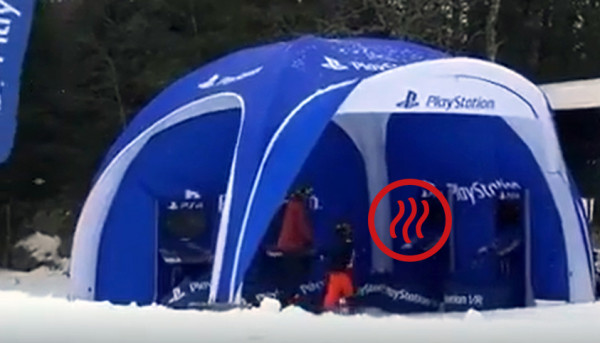X GLOO tents can be used all year round, in all weathers, on sand or snow - an X GLOO tent can be set up anywhere in just a few minutes, offering protection and putting your brand in the spotlight. With proper heating, the X GLOO tent is a comfortable location even in the colder seasons.
There is a wide range of tent heating systems available, each system has advantages and disadvantages. It is therefore important to choose the right system for the intended use.
Pleasant warmth through electric radiant heaters for tents (infrared)
The use of infrared heaters is particularly uncomplicated. These are electrically operated and immediately radiate pleasant warmth. No air masses are heated. This makes this heating method particularly efficient, as no energy is wasted on unnecessary areas (e.g. under the ceiling).
Electric infrared radiant heaters have the great advantage that they are very safe to use. There is no open flame and no burning - so even closed tents can be heated without hesitation.
Please note, however, that electric infrared heaters naturally require electricity. In order for the heaters to be used, a nearby power outlet or extension cable must be close to the tent.
Fan heater: Fast & efficient heating
If you want to achieve a fast, active distribution of heat in a tent, heater fans can also be used. These heaters have a high air circulation, which ensures a quick distribution of heat. The cold ambient air is also swirled and mixed with the heated air. The heat is thus distributed quickly and evenly throughout the tent.
The disadvantage: this tent heating also requires electricity.
Gas radiant heater: heating independent of electricity
If you want to be independent of electricity and use gas heating to keep a large tent warm, you should consider a gas radiant heater. Compared to a fan heater, a radiant heater heats large rooms rather selectively. However, the decisive advantage of this tent heater is the fact that you can heat independently of the power socket. Thanks to the gas-powered tent heater, you are completely mobile when it comes to setting up the heater. Please observe the required minimum distance from the tent skin, especially towards the top, to prevent the material from overheating.
Important note: When using gas radiant heaters, do not use tent walls. Observe the required minimum distance to the roof cladding to prevent overheating of the material.
Gas heater for tents
With gas fan heaters, make sure that they are placed outside the tent. Outside air is heated in the fan heater and then blown into the interior. The heating hose is led through a wall with a heating hose passage. The units can be turned and rotated very easily in all directions and thus provide a comfortable temperature very quickly without requiring a power connection. Fan heaters are suitable for larger enclosed tents due to their fast and lasting heating power. Another advantage is the position of the gas bottle connected to the unit outside the tent. This not only reduces the risk of accidents such as the gas cylinder tipping over, but also simply looks better.
Only use gas fans that are explicitly suitable for indoor use.
SAFETY MUST BE GUARANTEED!
When using tent heaters, make absolutely sure that they must be approved for indoor operation. In addition, the distance from the heater to the tent and other flammable objects should be generous. The heater should be placed where there is least risk of collision to prevent burn injuries.

